-
Car Reviews
- All reviews
- Midsize SUVs
- Small cars
- Utes
- Small SUVs
- Large SUVs
- Large cars
- Sports SUVs
- Sports cars
- Vans
Latest reviews
- Car News
-
Car Comparisons
Latest comparisons
- Chasing Deals
The popular but hard-riding W205 C-Class has been ousted by the new W206-gen, which aims to restore the Baby Benz to its traditionally supple character
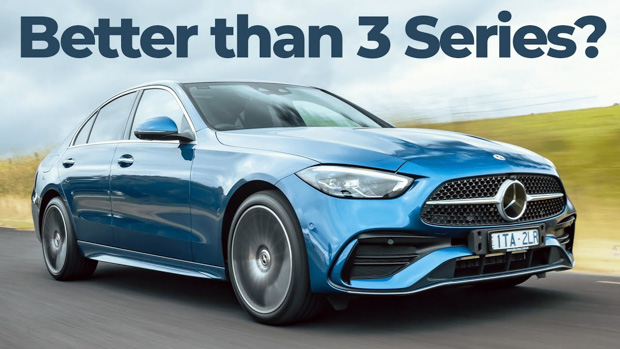
In something of a relief to traditional Mercedes-Benz buyers, the new W206-generation C-Class returns the model to its roots as a compact sedan that plays to the brand’s strengths – a supple ride teamed with a high-quality interior.
It might have been the most successful generation in the history of the C-Class, but the outgoing W205 model was not regarded in Australia for its ride or build quality – particularly given it replaced an undisputed high watermark for Benz: the vault-like 2007-2013 W204.
On a first drive over about 400km through Melbourne and country Victoria, this W204-owning tester feels that the W206 restores a good deal of the former vehicle’s quality in both interior parts fitment and suspension compliance.
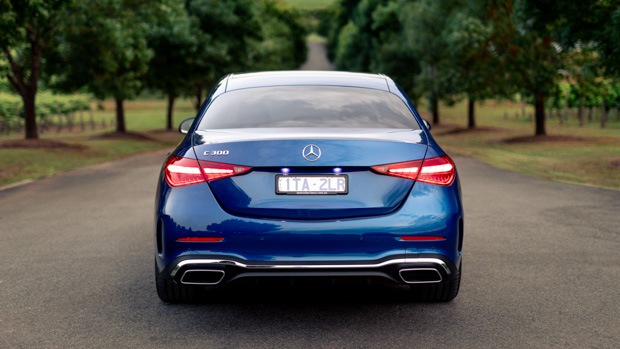
That’s appropriate, given the entry and rise of the A-Class hatch and sedan, and CLA sedan, as entry-level Mercedes-Benz products in Australia that trade on a sportier reputation. Once known as the ‘Baby Benz’, the C-Class can now resume its role as a small(ish) rear-wheel drive sedan with a trademark supple ride and laid-back attitude.
Few cars in the contested midsize luxury sedan segment have a laser-focus on comfort, though the jack-of-all-trades G20 BMW 330i makes life difficult for all-comers. Equally, the Audi A4 is strong in many areas, while the Jaguar XE and Alfa Romeo Giulia are enthusiast choices.
So, does the new Mercedes-Benz C-Class differentiate itself from the pack and give Australian buyers a reason to pony up considerably more money than before?
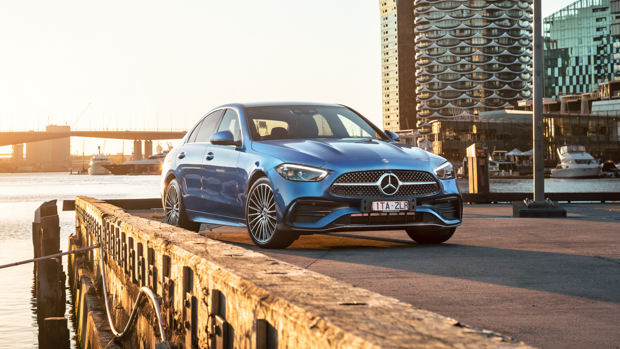
A move to fixed national pricing means this is a costly vehicle with no room for negotiation. The launch range takes in two identically-priced C200 variants ($78,900 before on-road costs) and a higher-performance C300 ($90,400).
You can still haggle on an A4, 3 Series, XE or Giulia, but Mercedes-Benz are confidently joining Honda, Genesis and Tesla in attempting to entrench fixed pricing as an automotive retail concept in Australia.
Whether and how buyers take to the model remains to be seen, but the German marque says they are happy with the move.
Like all W206 models are slated to be – including the forthcoming C53 and C63 – the C200 and C300 are turbocharged four-cylinder cars, with these everyday models also equipped with a 48-volt mild hybrid system that adds a modest additional boost.
Most other sedans in this segment – and there is no wagon available, sadly – are still sold with the option of a six-cylinder engine (BMW M340i and M3, Audi S4 and RS4, Alfa Romeo Giulia Quadrifoglio). The new C-Class will not join them.
Instead, the highest-performance W206 will be the 2023 C63 that uses Benz’s A45 hot hatch powertrain (310kW/500Nm) in concert with a plug-in hybrid system that should provide a 400kW punch and a short amount of electric-only driving range. A mainstream plug-in hybrid C-Class with about 100km electric range will also be available.
We also expect to see a C53 model: this might do without the PHEV system in favour of a beefy self-charging mild-hybrid setup akin to that in the six-cylinder E53 and GLE53 models.

It will be a brave new electrified world for AMG versions of the C-Class, but the everyday lineup that launched this month is quite a bit more conventional. Premium petrol goes in one end and combustion occurs, with the nine-speed automatic transmission-mounted mild-hybrid system providing light relief to the engine along the way.
Derivatives of the same M254 petrol four-cylinder engine, both the C200 and C300 motivate the C-Class well enough – though the $12K-dearer C300 offers notably more urge and will be the pick for those doing plenty of country driving.
But we liked the 150kW/300Nm C200 too. Far from feeling underdone, the 1.5-litre sounded rousing and liked to be kept on the boil through systems of corners. The torque isn’t quite sufficient to wiggle the tail, though, whereas the 190kW/400Nm C300 feels strongly rear-drive underfoot.
Still, we’d call both engines more than fit-for-purpose. We do wish the calibration of the nine-speed auto was a bit slicker; it’s not really a patch on BMW’s tune of ZF’s eight-speeder and the Audi seven-speed dual-clutch unit is also a smoother operator.
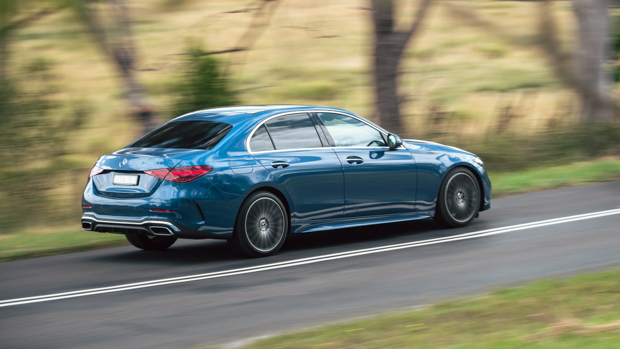
The cars we drove were brand new and perhaps additional kilometres would see the hunting auto settle quite a bit.
Traditionally if you were buying a C-Class it was because you didn’t mind that the BMW and Audi options were a bit quicker – you wanted a supple ride.
Finally, you’ll find this virtue on a C-Class again. AMG Line exterior and interior styling might be standard on the Australian cars (except for the rare and desirable C200 Avantgarde Edition C!) but there is no sports suspension to diminish comfort.
Instead, a senior Mercedes-Benz Asia-Pacific executive told Chasing Cars that restoring a level of comfort was an explicit goal of the W206.
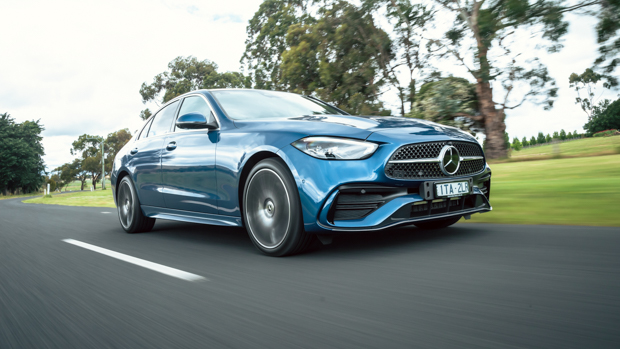
Two suspension setups will eventually be available: a passive steel-sprung setup and an upgraded adaptively-damped arrangement. Adaptive dampers are part of the Engineering Package, joined by rear-wheel steering – this is currently unavailable due to semiconductor shortages at the factory.
We’ve driven both suspension packages with 19-inch wheels (standard on C300, optional on C200) and you can’t go too wrong. The standard passive suspension is supple, blending comfort and compliance; we only challenged it when cornering on poorly-surfaced B-roads where it ran out of travel a bit too quickly, finding bump stops.
We suspect that with the C200 and C200 Edition C’s more cushioning standard 18-inch wheels, the passive suspension will be totally satisfactory – which is more than we can say for the BMW 320i which tends to crash about on its passive dampers.
Equally, the C300 on 19-inch wheels will likely cope on standard suspension but if you’re spending $90K+ on a C-Class, we’d recommend waiting until you can order the Engineering Package with adaptive dampers in future, as these create a soft, wafting character many buyers will be looking for.
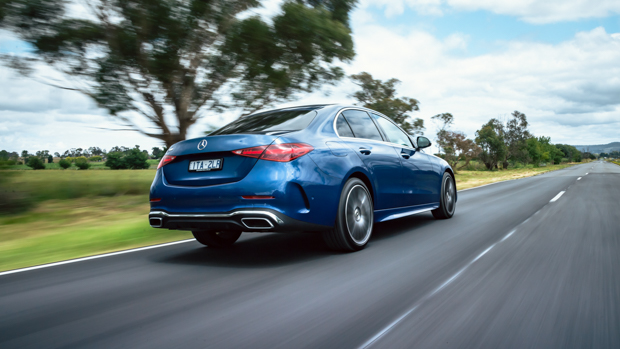
That said, we didn’t find an ideal adaptive damper setting, with Comfort feeling a touch boaty and Sport inducing too much fidget (forget about Sport Plus on Australian roads). This leaves the perfectly-suspended BMW 330i (with standard adaptive dampers) as the standing benchmark for ride in this segment.
We quite liked the new steering rack on the W206, though, which loads up quickly and delivers modest feedback from the road. It’s also delivered through a steering wheel that is not quite as comically thick as that used on the BMW 3 Series, though the delicate Giulia tiller remains our favourite in this class.
Noise suppression and refinement is impressive, particularly given the wide Goodyear rubber fitted to the launch cars – all of which had low-profile tyres and 19-inch wheels.
The safety systems fitted to the C-Class have more processing power than before, and you can tell: the lane keeping aid now centres the car diligently and operates smoothly, meaning you are less likely to disable it. There is forward, junction and reversing AEB.
That said, we find the blind spot cameras used by the Genesis G70 more intuitive than the C-Class’s old school triangular blind spot sensors.
As well as ride quality, we’ve been looking forward to testing the build quality of the new C-Class. Creaking centre consoles and door cards were unfortunately all too common on the W205, which represented a stark contrast from the immense quality of the Car of the Year-winning W204 that came before it.
We’re relieved to report that quality appears to have been given a significant boost here, with shut lines, trim fastening and materials used all seeming to be better than before – with the caveat that the vehicles we tested were only 1000km old.
To conduct a better test of whether improvements have truly been made, we have requested a long-term C-Class test vehicle that we can subject to 10,000km of hard driving for deeper insights.
There was an encouraging lack of flex, squeaks or rattles in each of the three vehicles we sampled – something that could not be taken for granted in the W205. Fit and finish on these German-assembled cars was very good.
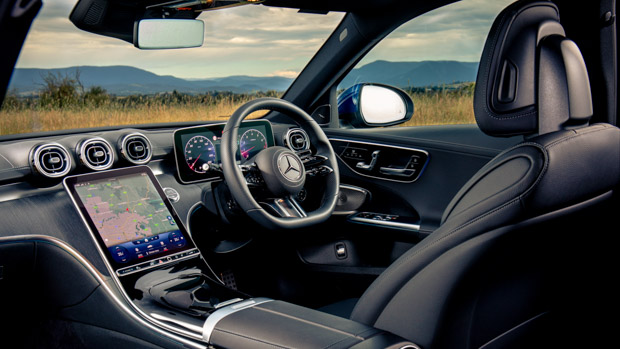
From an aesthetic standpoint, there has been a major shift away from the previous car’s infotainment screen, which was mounted high on the dash like a stuck-on tablet. Now integrated into the cascading centre console, the 11.9-inch near-square screen is better-placed and works well.
Running a new version of Benz’s MBUX software, shared with the flagship S-Class sedan, the interface is fairly intuitive and includes wireless Apple CarPlay and Android Auto, plus Mercedes’ own navigation and media systems that use an inbuilt data connection for traffic, search and vehicle-to-infrastructure functions.
With the central screen more tightly integrated, it’s a bit of a shame the digital driver’s display does the inverse, moving from a traditionally-cowled screen to an iPad-effect slate behind the steering wheel. The screen is easily bright enough to defeat any sun glare, but the piece itself looks like a bit of an afterthought.
Speaking of the steering wheel: the ‘Super Sport’ wheel design might be the worst piece of design in the whole car. It looks very cool, but the thin double-spokes on both sides housing typical shortcuts for media, screen control and safety features are a nightmare.

Driven via capacitive touch sensors, the steering wheel controls are simply way too small to be operated accurately even by somebody with relatively fine fingers. Add in the car’s motion and a bobbing country road and it’s often impossible to achieve simple tasks like altering the cruise control speed or changing the track
A redesign of the steering wheel controls should be prioritised, but the rest of the wheel is pleasant, finished in nappa leather with perforations that feel good underhand.
The leather sports seats fitted as standard to the C200 and C300 are reasonably supportive, though we could have done with more aggressive under-thigh angle adjustment. Heating is standard, though cooling is not available. Attractive colours take in black, black/grey, black/red and black/tan.
Soon, a C200 Edition C grade will join the W206 lineup in Australia with comfort seats (instead of sports), and no AMG Line detailing in sight – instead, Edition C is based on Europe’s more traditional Avantgarde spec. Don’t go looking for a bonnet star – sadly you won’t find one – but more formal specs like beige leather are available.
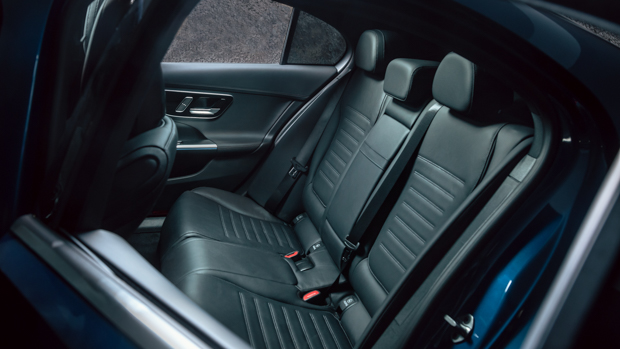
Unfortunately, the Burmester premium stereo fitted to some examples of the C-Class that are already in the country is – like adaptive dampers – also not currently available to order. While the Burmester required careful fine tuning before it sounded good, it’s considerably clearer than the standard Mercedes-Benz hi-fi that is only just adequate.
The back seat is spacious enough for two more adults, though the C-Class isn’t the roomiest car in the class. Headroom and legroom are OK, but the 3 Series feels bigger throughout. Plus, the deletion of the C-Class wagon means there is no longer a compact but practical Mercedes-Benz that isn’t an SUV.
It is sad that Mercedes-Benz Australia did not see fit to renew the C-Class wagon for our market – or to bring in the new, raised/cladded C-Class All-Terrain – because the sedan’s boot is pretty small. At 445L, it’s noticeably smaller than the 3 Series sedan (and Touring) … and no variant has a spare tyre, either. Cars on 19-inch wheels have a tyre repair kit, while those on 18s (not driven on launch) have run-flat tyres … which may worsen the ride.
Adding a 48-volt mild hybrid architecture to the W206 C-Class has resulted in significant fuel consumption gains: across our varied 350km launch drive of the car in Victoria, we managed 8L/100km in the C300: not bad for the size of the vehicle and the performance on offer.
Servicing can be prepaid, which results in a saving when compared to paying as you go. It’s still not cheap, though – $5200 for a five year plan.
As always, the devil is in the detail: the Benz has longer service intervals than most rivals, so in five years you can drive 25,000km without a maintenance stop for a total of 125,000 covered kays, meaning the service pack costs about 4 cents per kilometre.
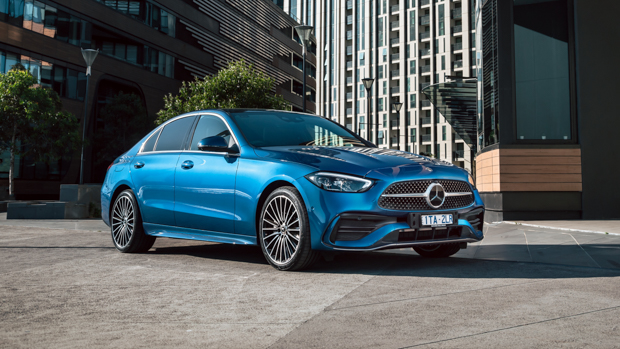
The Audi A4’s five year/75,000km service plan costs $2920, which works out to 3.9 cents per kilometre – so the C-Class is more or less the same value for a buyer doing serious mileage, but dearer to service if you don’t do significant distances per year.
Still, servicing is quite expensive on both of those models in light of the Genesis G70 sedan, which is sold with five years/50,000km of free scheduled maintenance in Australia.
Mercedes-Benz applies a five year, unlimited kilometre warranty to each of their models in Australia.
The mission for the new W206 C-Class was clear: restore most (or all) of the W204’s quality markers while keeping Mercedes-Benz aligned on its path towards electrification, high-technology interiors and national pricing model. In other words, to move forward while pulling a few greatest hits out of the back catalogue.
Has it succeeded? Things look good. We need to put quite a few more kilometres on a range of C-Class examples before we can give a definitive answer on build quality, but the vehicles we did drive at launch seemed better-made than their at-times underwhelming W205 predecessors.
It is disappointing that there is still no firm plan to bring the new plug-in hybrid C-Class to Australia, with its 100km electric range, but the C200 and C300 that have arrived at launch use impressive powertrains with punch and reasonable efficiency.
And the ride quality is much improved – that much is clear, even if the softest suspension, delivered via adaptive dampers, cannot currently be ordered due to semiconductor shortages. Even on passive dampers, the W206 is a more comfortable car than before.
We look forward to conducting a segment comparison with the BMW 3 Series, Audi A4 and others and conducting more detailed in-house testing shortly.
Variant tested C300
Key specs (as tested)
About Chasing cars
Chasing Cars reviews are 100% independent.
Because we are powered by Budget Direct Insurance, we don’t receive advertising or sales revenue from car manufacturers.
We’re truly independent – giving you Australia’s best car reviews.
The estimate provided does not take into account your personal circumstances but is intended to give a general indication of the cost of insurance, in order to obtain a complete quote, please visit www.budgetdirect.com.au. Estimate includes 15%^ online discount.
^Conditions Apply
Budget Direct Insurance arranged by Auto & General Services Pty Ltd ACN 003 617 909(AGS) AFSL 241 411, for and on behalf of the insurer, Auto & General Insurance Company Limited(ABN 42 111 586 353, AFSL 285 571).Because we don’t know your financial needs, we can’t advise you if this insurance will suit you. You should consider your needs and the Product Disclosure Statement before making a decision to buy insurance. Terms and conditions apply.
Indicative quote based on assumptions including postcode , 40 year old male with no offences, licence suspensions or claims in the last 5 years, a NCD Rating 1 and no younger drivers listed. White car, driven up to 10,000kms a year, unfinanced, with no modifications, factory options and/or non-standard accessories, private use only and garaged at night.
^Online Discounts Terms & Conditions
1. Discounts apply to the premium paid for a new Budget Direct Gold Comprehensive Car Insurance, Third Party Property Only or Third Party Property, Fire & Theft Insurance policy initiated online on or after 29 March 2017. Discounts do not apply to optional Roadside Assistance.
2. Discounts do not apply to any renewal offer of insurance.
3. Discounts only apply to the insurance portion of the premium. Discounts are applied before government charges, taxes, levies and fees, including instalment processing fees (as applicable). The full extent of discounts may therefore be impacted.
4. We reserve the right to change the offer without notice.